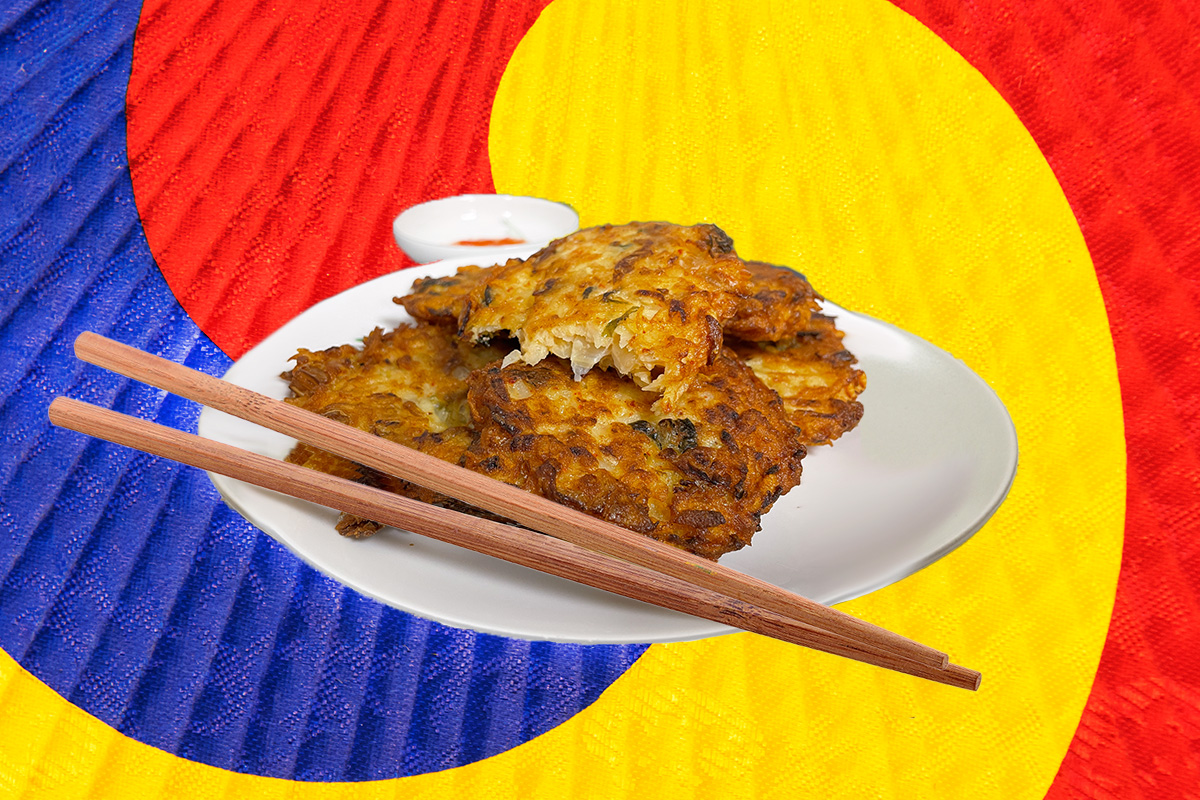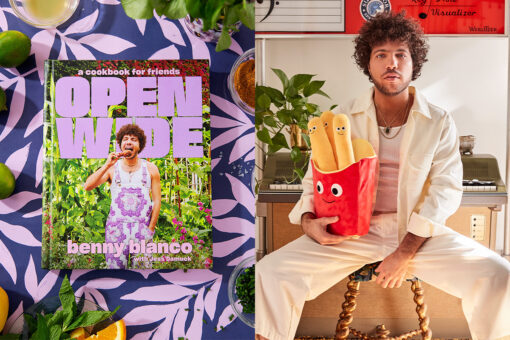This year, I’m making kimchi latkes for Hanukkah.
Let me tell you why:
Holding space for both my Korean and my Jewish identities in one breath has never been easy for me. I always feel like I’m toeing a line, being perceived as Jewish in one space and then as Korean in the next (or more likely just… confusing people). As the world around me has tried to categorize me as one or the other, my identity has started to feel cyclical, always Korean or Jewish — never both.
As I’ve searched for connections to both parts of my Jewish and Korean identity, food has always been a strong cultural link. My strongest memories from Korean school are of the cafeteria, where vendors sold kimbap, mandu and tteok, all plastic-wrapped and served on little Styrofoam plates. My favorite tteok was the sweet and colorful “rainbow tteok,” and I loved event days at the end of the year when the Korean school would set up frying pans so we could all take turns making dalgona candy. At home, my mom makes jjapchae for every potluck event we go to, and my maternal grandmother makes tteokguk whenever we come over. As I’ve gotten older and my spice tolerance has grown, kimchi-egg-rice bowls have become a dietary staple.
Through my Jewish identity, which I’ve admittedly felt a stronger connection to recently, I learned to braid challah in my kindergarten kesher class before I even knew how to braid hair. Before I began going to Hebrew school, my greatest link to Judaism was my mom’s brisket and my family’s love of matzah ball soup. At least one family member always brought a kugel to Thanksgiving. Once I hit middle school, I started my own traditions: matzah toffee every Passover and an apples and honey challah loaf every Rosh Hashanah.
When I moved away for college, I discovered that food is not only my greatest link to my heritage, but also my love language and my own personal method of self-discovery and cultural sharing. My first semester, I had five roommates, and we all used food to share our cultures with each other. One of my roommates made us chana masala. Another roommate made us a Persian picnic to celebrate sizdah bedar. I taught my roommates how to make mandu and hamantaschen and made them jjapchae for dinner. For Passover, I made my roommates a full spread of matzah ball soup, charoset and my yearly matzah toffee. Ultimately, sharing food heritages brought us closer as roommates and as friends.
This semester, I’m studying abroad in Seoul, South Korea as part of my lifelong journey to identify more strongly with my Korean heritage. And while I’m learning a lot about Korean customs and meeting family I’ve never met before, staying in Seoul through Hanukkah means my holiday celebration will be inherently different and inherently mixed. So, I turn again to my greatest tool: food.
In the story of Hanukkah, the Maccabees rededicate the Temple to Judaism and celebrate the right to practice their religion. For me, kimchi has a similar meaning: It is a celebration of Korean culture, and cooking with it is my rededication to the millennia-old kimchi-making traditions of my ancestors. On Hanukkah, we eat fried foods like latkes and sufganiyot to celebrate the miracle of the oil that would not stop burning. In Korea, I eat kimchi to celebrate the miracle of my family’s continued heritage, even after immigrating to the United States.
As I approach my Hanukkah spent abroad in Korea, I am looking to celebrate this holiday not just as a Jew, but as a Korean Jew. I want to honor the traditions of latke-making and the celebration of the miracle of the oil in a uniquely mixed way.
So, like I said: This year, I’m making kimchi latkes for Hanukkah. With this recipe, you can, too.
Kimchi Latkes
Yield: 6-7 latkes
Instead of serving these latkes with the traditional pairing of applesauce and sour cream, I would suggest Thai sweet chili sauce as a condiment and maybe even a perfectly fried, runny egg placed right on top: a delectable combination of crunchy, sweet, spicy and yolky.
Ingredients
- 3 medium-sized white potatoes
- 1 cup store-bought kimchi
- ½ white onion
- 2 large eggs
- ½ cup all-purpose flour
- Salt and pepper to taste
- Canola oil for frying
Steps
- Wash and peel potatoes. Lay a cheesecloth or clean dish towel over a bowl. Using the largest setting on a box grater, grate the potatoes over the bowl and into the cheesecloth.
- Use the cheesecloth to wring out as much liquid from the potatoes as possible, and place the grated potatoes into a large bowl.
- Peel the half onion and grate it into a bowl lined with a new cheesecloth, using the same size grater as the potatoes.
- Chop the kimchi into small pieces and put them in the cheesecloth with the grated onion. Wring the liquid from the onions and kimchi and place them with the potatoes in the bowl.
- Crack 2 eggs into the potato and kimchi mixture and mix. Add in the flour, salt and pepper to taste, and mix again.
- Put a shallow amount of canola oil in the bottom of a pan. Once the oil has heated up, form palm-size latkes and fry them for two to three minutes on each side, or until each side has turned a dark golden brown.
- Place the latke on a paper towel-lined plate to drain. Serve while still hot.



